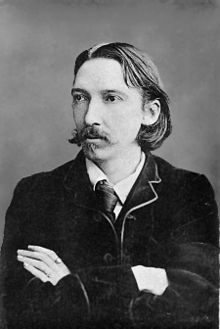


Robert Louis Stevenson (1850–1894)Robert Louis Stevenson was born in Edinburgh, Scotland on November 13, 1850. His mother came from a family of lawyers and church ministers. His father was a civil engineer who was raised in a family of engineers that had built many of the deep-sea lighthouses around the rocky coast of Scotland. Robert was their only child. He was very fond of the nurse who took care of him, and many years later he dedicated a book of poems, A Child's Garden of Verses, to her. Robert suffered from a respiratory disease, so he was rather sickly as a child. He would be kept indoors for the whole winter, where he spent a lot of time in his nursery playing with blocks, drawing, painting, and making up stories about faraway lands and exciting adventures. His formal education began at age seven, but he only attended school for a few weeks before his poor health kept him at home again. Since his frequent illnesses made regular schooling difficult, he was taught for a long time by private tutors. Two years later, nine-year-old Robert returned to Mr. Henderson’s Preparatory School. But according to biographer Jacqueline Overton, "His father did not believe in forcing him to study; so he roamed through school according to his own sweet will, attending classes where he cared to, interesting himself in the subjects that appealed to him—Latin, French, and mathematics—neglecting the others." Although his schooling was inconsistent, Stevenson read widely and he liked to write. What he loved most about school were the magazines he created, like "Sunbeam Magazine" and "Schoolboy Magazine" which featured "fact, fiction, and fun." At the age of seventeen, at the urging of his father, Stevenson enrolled at Edinburgh University to study engineering, with the aim of following in the family firm. However, he abandoned this course of studies and made the compromise of studying law. Still, he was much more interested in literature, and what he really wanted to do was write. On his summer vacations he went to France to be in the company of other young artists, both writers and painters. His first published works were all about traveling, which he enjoyed. In September of 1876, Stevenson met and fell in love with Mrs. Fanny Osbourne. They met at a riverside village southeast of Paris. He was twenty-five, and she was thirty-six year old American woman, separated from her husband. Two years later she obtained a divorce, and the following year when he learned that she was ill in San Francisco, he decided to go see her. He traveled as a steerage passenger and crossed the United States in the immigrant train. Stevenson wrote two stories in 1879, "The Amateur Emigrant" and "Across the Plains," which made use of his travel experiences in the United States. Early in 1880, Stevenson married Mrs. Osbourne. They spent a three-week honeymoon at an abandoned silver mine in California. Then he returned to Scotland with his new wife and her ten-year-old son, Lloyd. While on holiday in Scotland in the summer of 1881, cold rainy weather forced the family to amuse themselves indoors. Stevenson and his stepson drew, colored and annotated the map of an imaginary 'Treasure Island'. Stevenson's began to write a story based on it as entertainment for the rest of the family, and he continued to work on it while receiving medical treatment in Switzerland. It first appeared in the British magazine "Young Folks" as a weekly serial under the title "The Sea Cook," from 1881 to 1882. However, it didn't receive much attention until it was published as a book in 1883. Treasure Island marks the beginning of Stevenson's popularity and his career as a profitable writer. It was his first full-length fictional narrative, and the first of his writings for children. Stevenson's writing career flourished from 1880-1888. At the same time, his search for health took him to many corners of the world. In 1888, he decided to sail around the Pacific. When he and his family arrived in the Samoan islands in 1889, they built a house and settled there. This brought him a better climate for his still declining health, distance from distractions, and acted as a new stimulus to his imagination. He was inspired by the beauty and peaceful simplicity of island life. He wrote about the Pacific islands in several essays that would have gone towards a large work on the area that he had planned. The Samoan people on the islands loved Stevenson and looked up to him. They called him "Tusitala," meaning "teller of tales." Stevenson was a handsome man who was a great conversationalist, and he loved children. He was at the height of his writing career when he died suddenly of a stroke on December 3, 1894, when he was just 44 years old. As he had wished, he was buried on top of the mountain overlooking his home on Samoa. Appropriately it was his own short poem, 'Requiem', that was written on his tomb: 'Under the wide and starry sky, Dig the grave and let me lie…Here he lies where he longed to be; Home is the sailor, home from the sea.' Over the course of his life, Stevenson created some of the world's best-loved classics. For a long time, he was thought of mainly as a writer of adventure stories for children. Treasure Island, The Black Arrow, Kidnapped, and Catriona all have youthful protagonists and were first published in magazines for young people. But they are also clearly intended for adult readers. They are fictional narratives based on careful documentary research, exploring both history and culture. The stories are exciting, not because of exaggerations, but because they give an accurate picture of the action, so the reader feels like he is seeing everything as if he were there. Stevenson's stories are known for their realistic characters, memorable action, exciting suspense, vivid imagination, and clear, almost poetic style. He wrote plays, poems, essays, literary criticism, literary theory, biography, travelogues, reportages, romances, boys' adventure stories, fantasies, fables, and short stories-everything, it seems, except a traditional Victorian novel. Stevenson's love for travel is apparent in his works of fiction, most of which involve foreign or exotic lands. He has a brilliant way of combining a sense of wonder with an interest in well-researched topics. Stevenson's works earned him great popularity because of his clear and careful style, his ability to establish a personal relationship with the reader, and his extraordinary power as a storyteller. References http://www.bartleby.com/188/1000.html (Life of Robert Louis Stevenson, by Alexander Harvey.) http://www.gutenberg.org/files/15547/15547-h/15547-h.htm (The Life of Robert Louis Stevenson for Boys and Girls, by Jacqueline M. Overton.) http://www.theatlantic.com/past/docs/unbound/classrev/rlsteve.htm (Robert Louis Stevenson: A Review, by Bradford Torrey. "Stevenson was one of the happy few: he knew his life's business from childlhood. He was to write books.")
Contact: . Thanks! Please click here for reprint permission.


These pages are a continuous work in progress.
|
Help Support this Site
and purchase items via our affiliate links. Thank you!
 
Thank you for visiting my |

